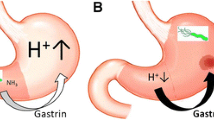Abstract
Helicobacter pylori infection enhances glandular stomach carcinogenesis in Mongolian gerbils (MGs) treated with N-methyl-N′-nitro-N-nitrosoguanidine and N-methyl-N-nitrosourea. A high-salt diet has been revealed to synergistically enhance development of stomach cancer with H. pylori infection; the latter exerts stronger promoting effects than the former. Eradication of H. pylori with antibiotics diminishes their enhancing effects. The earlier the eradication of H. pylori is undergone, the more effective is the prevention of gastric carcinogenesis in MGs. To explore whether the role of H. pylori infection is a cause of stomach carcinogenesis (initiator) or just a supporting actor (promoter), we established an experimental model of long-term (2 years) H. pylori infection and eradication in MGs without chemical carcinogens. Long-term H. pylori infection stimulated development of highly proliferative and dilated glands containing a large amount of mucin, called heterotopic proliferative glands (HPGs), resembling mucinous adenocarcinomas. However, no gastric carcinomas were found in MGs after 2 years of H. pylori infection in our system. After eradication of the bacteria, HPGs were obviously reduced, and gastric lesions were mostly alleviated. These findings showed that H. pylori infection is related to severe gastritis and that HPGs are frequently induced reversible lesions rather than being malignant in character. Helicobacter pylori infection thus appears to have a strong promotional influence but not to initiate gastric carcinogenesis.
Similar content being viewed by others
References
F Hirayama S Takagi Y Yokoyama E Iwao Y Ikeda (1996) ArticleTitleEstablishment of gastric Helicobacter pylori infection in Mongolian gerbils J Gastroenterol 31 24–8 Occurrence Handle8959513 Occurrence Handle10.1007/BF01211183
M Tatematsu M Yamamoto N Shimizu A Yoshikawa H Fukami Kaminishi et al. (1998) ArticleTitleInduction of glandular stomach cancers in Helicobacter pylori-sensitive Mongolian gerbils treated with N-methyl-N-nitrosourea and N-methyl-N′-nitro-N-nitrosoguanidine in drinking water Jpn J Cancer Res 89 97–104 Occurrence Handle9548434 Occurrence Handle1:CAS:528:DyaK1cXhs1Oqu78%3D
A Sugiyama F Maruta T Ikeno K Ishida S Kawasaki T Katsuyama et al. (1998) ArticleTitle Helicobacter pylori infection enhances N-methyl-N-nitrosourea-induced stomach carcinogenesis in the Mongolian gerbil Cancer Res 58 2067–9 Occurrence Handle9605743 Occurrence Handle1:CAS:528:DyaK1cXjt12hsbw%3D
N Shimizu K Inada H Nakanishi T Tsukamoto Y Ikehara M Kaminishi et al. (1999) ArticleTitle Helicobacter pylori infection enhances glandular stomach carcinogenesis in Mongolian gerbils treated with chemical carcinogens Carcinogenesis 20 669–76 Occurrence Handle10223198 Occurrence Handle10.1093/carcin/20.4.669 Occurrence Handle1:CAS:528:DyaK1MXis1CrtbY%3D
M Tatematsu M Takahashi S Fukushima M Hananouchi T Shirai (1975) ArticleTitleEffects in rats of sodium chloride on experimental gastric cancers induced by N-methyl-N′-nitro-N-nitrosoguanidine or 4-nitroquinoline-1-oxide J Natl Cancer Inst 55 101–6 Occurrence Handle808633 Occurrence Handle1:CAS:528:DyaE2MXlsVGmsLs%3D
K Nozaki N Shimizu K Inada T Tsukamoto M Inoue T Kumagai et al. (2002) ArticleTitleSynergistic promoting effects of Helicobacter pylori infection and high-salt diet on gastric carcinogenesis in Mongolian gerbils Jpn J Cancer Res 93 1083–9 Occurrence Handle12417037 Occurrence Handle1:CAS:528:DC%2BD3sXhvVeitg%3D%3D
S Kato T Tsukamoto T Mizoshita H Tanaka T Kumagai H Ota et al. (2006) ArticleTitleHigh salt diets dose-dependently promote gastric chemical carcinogenesis in Helicobacter pylori-infected Mongolian gerbils associated with a shift in mucin production from glandular to surface mucous cells Int J Cancer 119 1558–66 Occurrence Handle16646055 Occurrence Handle10.1002/ijc.21810 Occurrence Handle1:CAS:528:DC%2BD28Xos1KhtLg%3D
N Shimizu Y Ikehara K Inada H Nakanishi T Tsukamoto K Nozaki et al. (2000) ArticleTitleEradication diminishes enhancing effects of Helicobacter pylori infection on glandular stomach carcinogenesis in Mongolian gerbils Cancer Res 60 1512–4 Occurrence Handle10749114 Occurrence Handle1:CAS:528:DC%2BD3cXit1aqtro%3D
K Nozaki N Shimizu Y Ikehara M Inoue T Tsukamoto K Inada et al. (2003) ArticleTitleEffect of early eradication on Helicobacter pylori-related gastric carcinogenesis in Mongolian gerbils Cancer Sci 94 235–9 Occurrence Handle12824915 Occurrence Handle10.1111/j.1349-7006.2003.tb01426.x Occurrence Handle1:CAS:528:DC%2BD3sXktVCqs7g%3D
T Watanabe M Tada H Nagai S Sasaki M Nakao (1998) ArticleTitle Helicobacter pylori infection induces gastric cancer in Mongolian gerbils Gastroenterology 115 642–8 Occurrence Handle9721161 Occurrence Handle10.1016/S0016-5085(98)70143-X Occurrence Handle1:STN:280:DyaK1czoslynsA%3D%3D
S Honda T Fujioka M Tokieda R Satoh A Nishizono M Nasu (1998) ArticleTitleDevelopment of Helicobacter pylori-induced gastric carcinoma in Mongolian gerbils Cancer Res 58 4255–9 Occurrence Handle9766647 Occurrence Handle1:CAS:528:DyaK1cXmsVyqs7Y%3D
F Hirayama S Takagi E Iwao Y Yokoyama K Haga S Hanada (1999) ArticleTitleDevelopment of poorly differentiated adenocarcinoma and carcinoid due to long-term Helicobacter pylori colonization in Mongolian gerbils J Gastroenterol 34 450–4 Occurrence Handle10452676 Occurrence Handle10.1007/s005350050295 Occurrence Handle1:STN:280:DyaK1MznvFOntw%3D%3D
K Nozaki N Shimizu T Tsukamoto K Inada X Cao Y Ikehara et al. (2002) ArticleTitleReversibility of heterotopic proliferative glands in glandular stomach of Helicobacter pylori-infected Mongolian gerbils on eradication Jpn J Cancer Res 93 374–81 Occurrence Handle11985786 Occurrence Handle1:CAS:528:DC%2BD38Xks1Ojt7w%3D
X Cao T Tsukamoto K Nozaki N Shimizu T Mizoshita T Kumagai et al. (2004) ArticleTitleEradication of Helicobacter pylori induces apoptosis and inhibits proliferation of heterotopic proliferative glands in infected Mongolian gerbils Cancer Sci 95 872–7 Occurrence Handle15546504 Occurrence Handle10.1111/j.1349-7006.2004.tb02196.x Occurrence Handle1:CAS:528:DC%2BD2MXot1Oktg%3D%3D
Author information
Authors and Affiliations
Rights and permissions
About this article
Cite this article
Tatematsu, M., Tsukamoto, T. & Toyoda, T. Effects of eradication of Helicobacter pylori on gastric carcinogenesis in experimental models. J Gastroenterol 42 (Suppl 17), 7–9 (2007). https://doi.org/10.1007/s00535-006-1927-6
Published:
Issue Date:
DOI: https://doi.org/10.1007/s00535-006-1927-6




